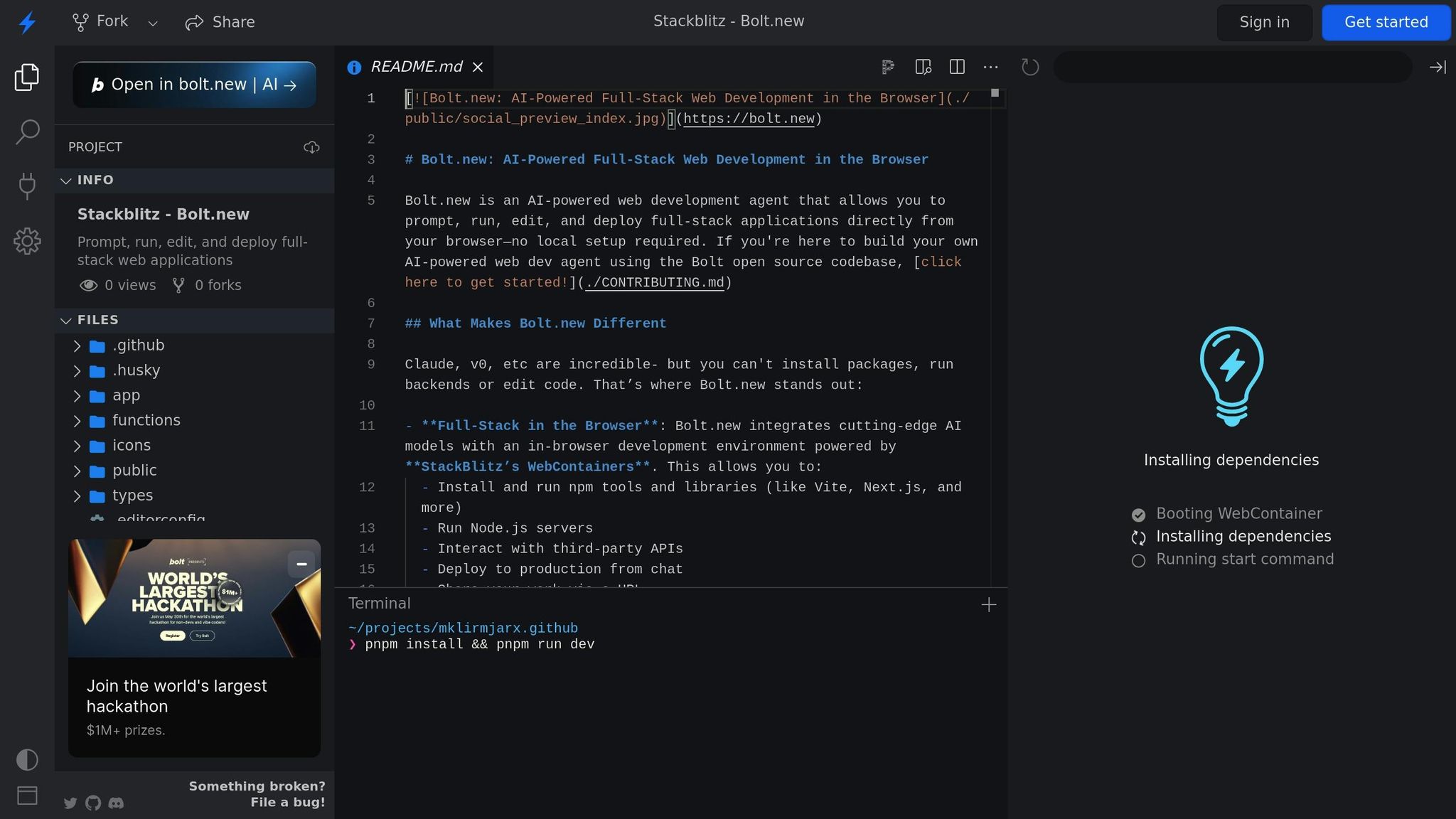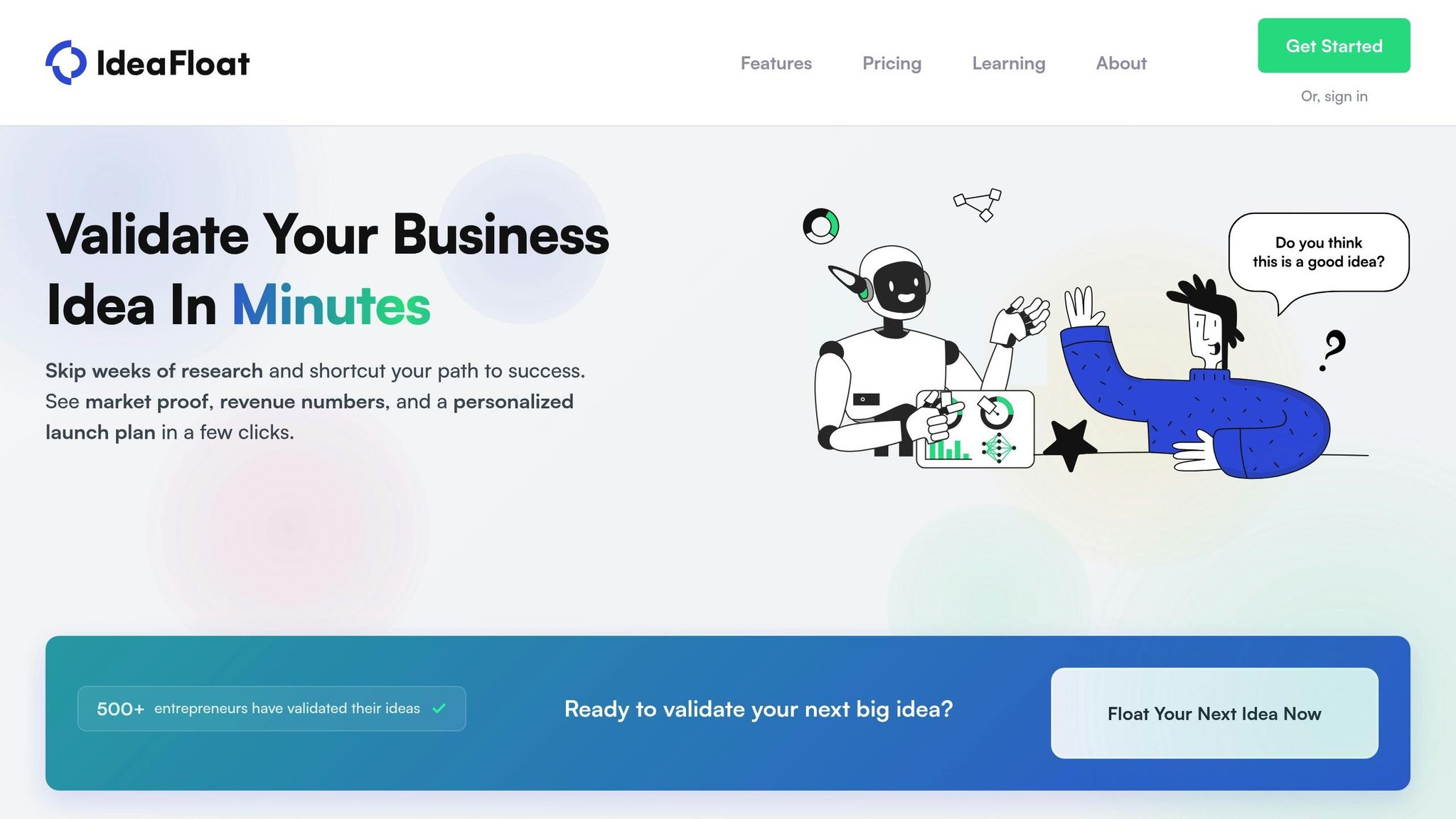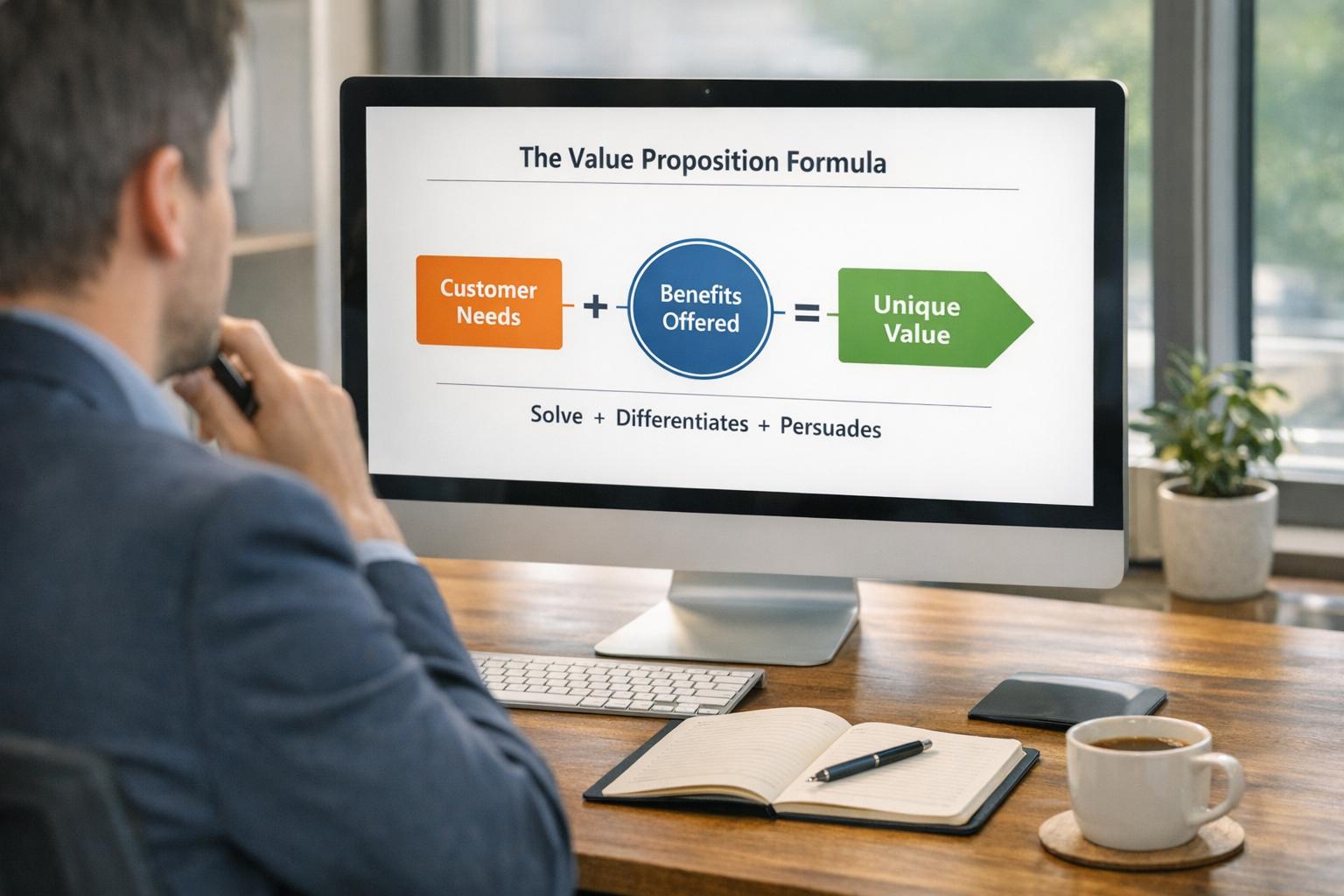
When my digital marketing consultancy started losing money, I knew I needed a fast, affordable solution. Traditional consulting wasn’t an option, so I turned to IdeaFloat’s AI tools. These tools helped me:
- Identify key problems like unclear services, a broad target audience, and poor market alignment.
- Refocus my business on specialized services for high-demand niches like SaaS and fintech.
- Use real data to validate new strategies and refine my offerings.
- Create a detailed financial plan to ensure profitability.
In just six months, I went from barely breaking even to running a profitable, focused business. IdeaFloat’s AI gave me the clarity and tools to make decisions based on data, not guesswork, saving both time and money.
Keep reading to learn how I made the shift and the steps I followed to turn my business around.
How Bolt Hit $40M ARR in 5 Months with This AI Pivot Strategy | Stackblitz(Bolt.new), Eric Simons

Finding What Was Wrong Using IdeaFloat's AI Tools

When I hit a wall with my business, I decided to go back to basics. That’s when IdeaFloat's suite of AI tools became my go-to resource, helping me uncover issues I had been too close to recognize.
Getting Clear on What My Business Actually Did
I thought I understood my business inside and out - until I used IdeaFloat's Business Summary Generator. It quickly exposed a major problem: my mission and offerings were vague. The AI pushed me to clearly define my mission, services, and target audience. For the first time, I realized I had never articulated these things effectively.
The analysis revealed that I lacked a clear value proposition. My consultancy wasn’t standing out because my business description was generic and unfocused. I was offering everything - social media management, SEO, content creation, email marketing, and paid advertising - but excelling at nothing in particular. IdeaFloat's Unique Value Proposition Generator highlighted this issue and showed me that the market increasingly rewards specialization, not generalization.
Another major gap? I hadn’t defined my ideal customer. Instead of targeting a specific audience, I was casting a wide net across various industries. This unfocused approach led to ineffective marketing, inconsistent pricing, and scattered service delivery. The AI made it clear: without a well-defined identity, my business would struggle to differentiate itself in a crowded market.
This newfound clarity set the stage for identifying deeper market and customer mismatches.
Finding Market Problems and Customer Mismatches
The real turning point came when I used IdeaFloat's Market Size Assessment and Customer Profiling tools. They revealed just how disconnected I was from my market. I had been targeting an oversaturated, price-sensitive segment - one that wasn’t aligned with my strengths.
The Real Customer Insights feature was a game changer. By scanning forums and social media, it provided real-world data about what customers were saying. It became clear that my ideal clients weren’t the small businesses I had been chasing. Instead, narrowing my focus would allow me to deliver more tailored, strategic solutions.
The market analysis also uncovered opportunities I had completely overlooked. While I was competing locally for small business clients, there was a growing demand for specialized B2B marketing expertise in industries like SaaS startups, fintech, and healthcare technology. These insights gave me a new perspective on where my services could thrive.
Armed with this market knowledge, I turned my attention inward to evaluate my strengths and weaknesses.
Mapping Out Strengths and Problems
IdeaFloat's SWOT Analysis Generator became my roadmap for strategic change. It provided an unbiased look at my internal strengths and weaknesses, along with external opportunities and threats. This tool helped me prioritize what needed fixing.
The analysis revealed strengths I had been overlooking, like my years of experience, strong analytical skills, and a proven ability to improve client metrics. But it also forced me to confront long-ignored weaknesses, such as poor positioning, inconsistent pricing, and a lack of a client retention strategy.
Externally, the AI highlighted growing trends I could tap into, like the rising demand for data-driven marketing, privacy-focused advertising, and marketing automation. At the same time, it flagged challenges like increased competition, the rise of DIY marketing tools, and economic pressures on marketing budgets.
The Competitive Analysis Generator offered a fresh perspective on my competitors. Many of them were making the same mistake I was - trying to serve everyone instead of focusing on a niche. This insight underscored an important takeaway: specialization could be the key to turning things around.
Ultimately, the data showed that my biggest issue was a lack of focus. I wasn’t solving a specific problem for a clearly defined audience. Instead, I was offering generic solutions to anyone who would listen. With the help of IdeaFloat's AI tools, I finally saw my business for what it truly was - and what it could become.
Testing New Ideas with Real Market Data
After identifying key flaws in my business, I turned to real market data to test new strategies. This is where IdeaFloat's data-driven tools truly stood out, enabling me to validate each idea with actionable insights from the market.
Creating and Refining New Business Ideas
Using IdeaFloat's targeting tools, I shifted my approach to focus on specific niches. Instead of spreading myself thin, I explored areas like SaaS automation, fintech content, and healthcare lead generation.
The AI played a pivotal role in shaping distinct value propositions for these niches. For SaaS, it suggested: "Data-driven marketing automation that converts trial users to paying customers through personalized nurtures." This was a far cry from my earlier, more generic messaging and gave me a sharper, more compelling angle.
Another game-changer was the Business Name Generator. Many of my original name ideas either lacked clarity or were already taken. The tool provided suggestions that immediately communicated expertise in my target industries, which was critical for repositioning my business.
One of the most valuable lessons was the importance of specialization. While I initially tried to keep my services broad, the data consistently showed that a focused approach yielded a stronger market position. With these refined ideas in hand, I moved on to validate them through customer feedback.
Using Customer Feedback and Market Research
Next, I tapped into customer insights to test these newly refined concepts. The Real Customer Insights feature transformed how I understood my target markets. By analyzing forums, social media, and online conversations, the AI revealed authentic feedback on real challenges.
For the SaaS marketing niche, for example, it uncovered recurring pain points like poor trial-to-paid conversion rates and ineffective onboarding processes. These insights highlighted the need for a more tailored solution, reinforcing the direction I was heading.
This market data gave me confidence that my new strategies addressed genuine needs and filled clear gaps in the market. What would typically take months of research was condensed into just a few hours, thanks to these tools.
Refining Ideas Through Feedback
Customer feedback became the cornerstone of my strategic pivot. The Feedback Generator allowed me to test my refined business ideas with potential clients before fully committing. I created targeted surveys based on my updated positioning.
The response was overwhelmingly positive for the specialized SaaS marketing automation services compared to my previous, more generalized approach. This validation was invaluable, but it also highlighted areas for improvement. For instance, some respondents were unclear about what "marketing automation" meant, prompting me to simplify my messaging and include case studies to make the concept more tangible.
"IdeaFloat saved us weeks of work by helping us explore demand for new products across different regions and took the guesswork out of finding gaps in the market. A must-have for entrepreneurs looking to scale." - Nick Sherwing, Founder of woohoPets
These insights and validations were instrumental in shaping the new direction of my business, ensuring that every step was aligned with real market needs.
Predicting Profits and Planning the Business Change
Once I had solid ideas to pivot my business, it was time to face the numbers. Understanding the financial reality of this shift was crucial, and this is where IdeaFloat's financial modeling tools made all the difference. The leap from simply hoping for success to actually planning for it came down to having clear, data-driven financial predictions.
Running Financial Models for New Business Directions
I started with the Pricing Analyzer. Since my new focus was on SaaS marketing automation, the tool analyzed market rates, competitor pricing, and value propositions. It recommended a tiered pricing structure that aligned better with current market trends. This approach replaced my previous flat-rate model and showed a clear path to increasing revenue potential.
Next, the Startup Cost Analyzer gave me a detailed breakdown of the financial investment required for the pivot. It accounted for operating expenses and marketing costs, providing a comprehensive cost overview. To top it off, the Breakeven Analysis revealed that the updated model needed fewer client sign-ups to hit profitability. It also highlighted a faster return on investment, giving me the confidence to map out a strong funding and operational plan.
Planning Financial Structure and Funding Requirements
Based on these insights, I turned to the Funding Calculator to figure out how much capital was needed to make this transition. It accounted for operational costs and marketing investments while modeling different funding scenarios. This helped me weigh the trade-offs between taking on debt and preserving equity.
The Finance Structure Planning tool was equally valuable. It projected monthly cash flows and revenue growth while factoring in seasonal fluctuations. This allowed me to create an effective budget and build cash reserves for slower periods. With these tools, I could lay out a financial framework that balanced risk and opportunity.
Comparing Old vs New Financial Results
The updated financial projections confirmed that pivoting to a SaaS-focused model was the right move. A side-by-side comparison of the old and new business models highlighted major flaws in my original approach. The new direction not only increased revenue potential but also reduced the resources needed to break even.
These financial insights guided every decision I made during the pivot. By eliminating much of the guesswork, I was able to move forward with confidence, knowing my new direction was backed by solid numbers.
sbb-itb-08dd11e
Making the Change and Getting Results
With clear financial projections in hand, I shifted from strategy to action. Turning plans into reality demanded precise coordination, but IdeaFloat's tools made the process far less daunting. What could have been a chaotic pivot turned into a well-structured, step-by-step transformation. This phase built seamlessly on the insights and clarity gained during the earlier planning stages.
Building a Step-by-Step Action Plan
Using the validated market insights and financial forecasts, the Personalized Launch Checklist provided a tailored roadmap for my shift from digital marketing to SaaS marketing automation. The Lean Canvas Generator condensed my business model into a concise, one-page overview. Together, these tools broke down what seemed like an enormous undertaking into weekly tasks that were easy to manage. They also prioritized critical updates, helping me identify potential gaps and ensure every aspect of the pivot aligned smoothly.
"IdeaFloat walks you through a step-by-step plan to discover, validate and launch your business." - Lachlan Nicolson, Business Coach at Leader Guide
The checklist tackled the unique challenges of transitioning an established business. It included steps for managing existing clients, updating legal documents, and maintaining cash flow during the shift - essential elements for keeping the business steady while embracing change.
Sharing Plans with Investors and Partners
The Business Plan Generator created a detailed plan tailored for stakeholders. It included market analysis, competitive positioning, and financial projections - all reflecting the specific pivot strategy and market opportunity I had developed. This tool reinforced the value of a data-driven approach, mirroring the methods introduced earlier in the process.
"Any existing business that is considering scaling up or changing direction should be using IdeaFloat. It is an incredibly powerful tool." - Bernie Fitzsimon, Entrepreneur and Managing Director, LighthouseHQ
The Share Links feature made collaboration with partners and investors effortless. Instead of managing endless attachments or scheduling multiple meetings, I could provide secure access to up-to-date business plans, financial models, and market research. Stakeholders could review the materials at their convenience and offer feedback directly through the platform. This approach was particularly helpful when presenting the pivot to existing clients, as it demonstrated how the new direction would better serve their needs.
Results Achieved and Lessons Learned
Executing the action plan and engaging stakeholders led to measurable results. Within six months, the pivot boosted client retention and revenue, transforming the business from barely breaking even to achieving consistent profitability. The Validate Score feature confirmed that these changes resulted in a stronger market fit and a more stable financial foundation.
"IdeaFloat will save me and my team countless hours of work, as we help clients articulate their business ideas." - Robert Bates, Partner at McFillin Accounting
The biggest takeaway? Data-driven decisions removed uncertainty and gave me the confidence to act decisively when opportunities arose.
This journey highlighted the importance of balancing speed with thorough planning during a pivot. While it might be tempting to rush through changes during tough times, taking the time to validate ideas and carefully plan the transition is crucial for reducing risks and ensuring long-term success.
FAQs
How does IdeaFloat's AI help entrepreneurs identify and fix business challenges?
How IdeaFloat's AI Helps Entrepreneurs
IdeaFloat's AI takes the guesswork out of entrepreneurship by diving deep into data from market trends, customer feedback, and online conversations. It identifies hidden opportunities and pinpoints key challenges, giving business owners a clearer path forward. This means you can validate ideas faster by assessing market demand, competition, and consumer behavior - all without wasting valuable time.
What sets IdeaFloat apart is its ability to go beyond problem-spotting. Its AI tools deliver practical insights that help you adjust your business model and move toward profitability. By using these smart features, entrepreneurs can make quicker, well-informed decisions that match both market trends and customer expectations.
How can IdeaFloat's AI tools improve market analysis and help businesses develop better strategies?
How IdeaFloat's AI Tools Help Businesses Make Smarter Decisions
IdeaFloat's AI tools are designed to help businesses make informed decisions by delivering insights grounded in data. These insights enhance market analysis and refine strategy development, giving companies a better grasp of customer needs and market trends. The result? Businesses can take more precise and impactful actions.
With features like predictive forecasting and customer feedback analysis, IdeaFloat enables companies to spot potential risks and fine-tune their strategies. By tapping into real-time data, businesses can adjust quickly to market changes, innovate effectively, and maintain a competitive edge in an ever-evolving landscape.
How can I use IdeaFloat's AI tools to successfully pivot my business?
To make the most of IdeaFloat's AI tools when shifting your business strategy, start by taking a close look at your current market. Pinpoint areas where there are gaps or untapped opportunities. Tools like market analysis, customer feedback synthesis, and profitability forecasting can provide you with the insights needed to make smarter, data-backed decisions. This way, you minimize risks while uncovering strategies that have real potential.
Start with small, manageable adjustments to test your new direction before diving in completely. Keep a close eye on the results and use the AI-generated insights to refine your approach. By staying adaptable and letting the data guide your decisions, you’ll set your business up for sustained growth and success.
Related Blog Posts
Get the newest tips and tricks of starting your business!


